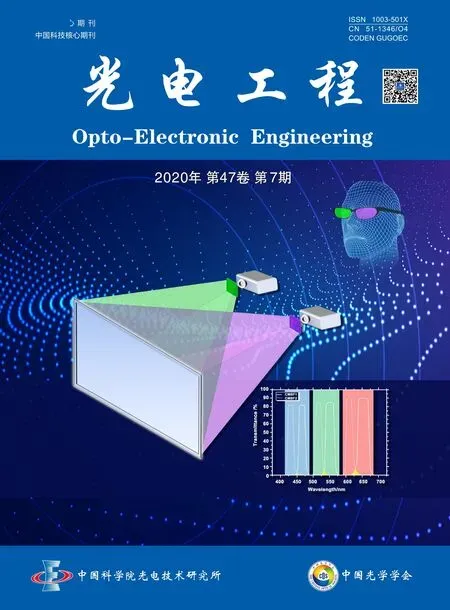可见光通信系统光源优化布局模型
刘 红,翟长鑫,文燕燕,席 磊,杜宗育
可见光通信系统光源优化布局模型
刘 红1,2*,翟长鑫1,2,文燕燕1,2,席 磊1,2,杜宗育1,2
1长春理工大学光电工程学院,吉林 长春 130022;2长春理工大学光电工程国家级实验教学示范中心,吉林 长春 130022
针对可见光通信系统存在的光照度和接收平面功率分配不均匀的问题,提出了基于多种群遗传算法的光源布局模型。以15个LED灯为例,构造和接收功率方差有关的适应度函数,采用多个种群协同进化的方式,对LED灯的位置坐标信息进行寻优。经Matlab R2016a仿真结果表明,优化后的功率分布直观上更均匀,功率方差达到1.5744 dBm,照度范围为889 lx ~1009 lx,照度均匀度亦达到91.73%,均优于传统遗传算法优化的布局和多种群遗传算法优化的矩形布局,从而为系统优化LED灯布局使得用户获得更好的通信体验提供了一种借鉴方案。
可见光通信系统;光源布局;照度均匀度;功率均匀性;多种群遗传算法
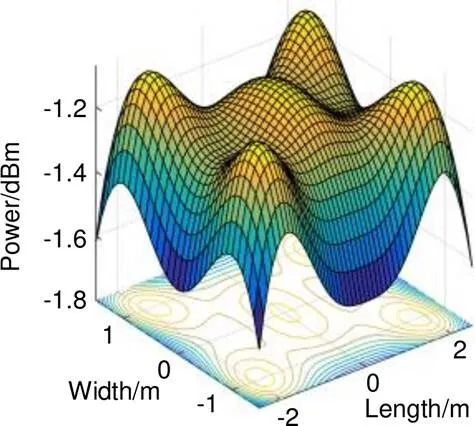
1 引 言
21世纪是数据爆炸式增长的时代,光通信技术因其信噪比高,调制速率快,保密安全性好的优点逐步取代传统的无线通信,可见光通信也成为了研究的热点之一。在可见光通信[1-5](visible light communication,VLC)系统中,为使照度分配均匀和通信功率覆盖均衡化,使用户得到更好的通信体验,常采用算法对LED的布局进行优化,王加安等[6]以能量损耗最小为原则,采用PSO算法优化LED圆形阵列的相关参数;Ding等[7]提出进化算法,以接收功率的比值为目标函数,对LED的发光光强进行优化;Liu等[8]提出基于基因密度的改进遗传算法,以接收光功率方差最小为原则,对LED的位置进行优化。多种群遗传算法(multi-population genetic algorithm,MPGA)采用多个种群协同进化的方式,在多元函数寻优方面往往能得到一个较为理想的结果。基于该算法,本文针对接收平面是长方形的情形,以接收功率方差最小化为目标函数,对LED的位置进行优化,使得照度和功率分布更均匀,提高了通信系统的性能。
2 可见光通信系统模型

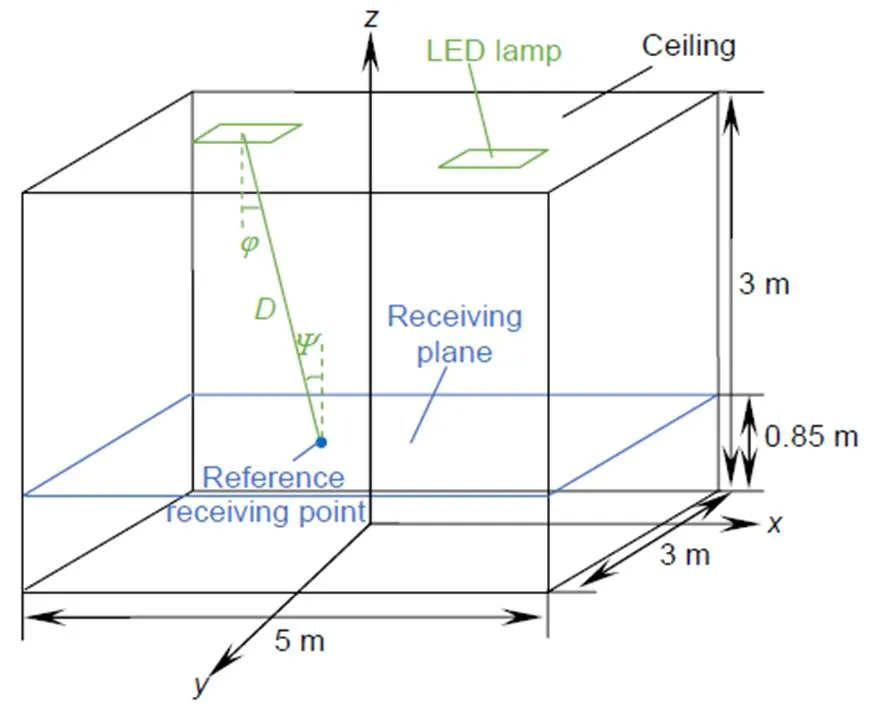
图1 VLC系统模型



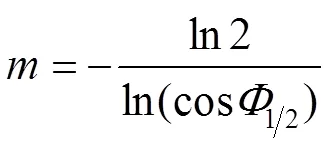
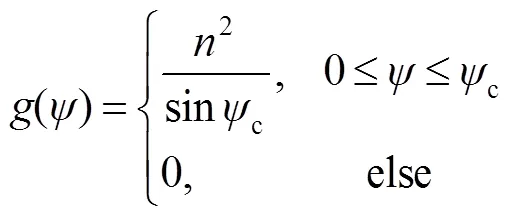
功率表征VLC系统的通信性能的好坏,VLC系统的另一个重要参量为光照度,用来表征系统照明的质量。
假设系统采用的LED为朗伯辐射源,发光强度表示为

则接收机接收来自单个LED的照度为

天花板上LED灯的排布位置如图2所示,第一象限有三个位置摆放LED灯,基于长方形的对称性,在其余三个象限的相应位置摆放相应的LED灯,在轴上关于轴对称上下各摆放一个LED灯,在原点位置处摆放一个LED灯,共计15个LED灯,通过对称性,可以得到五组不同的模式。
系统仿真参数如表1所示。
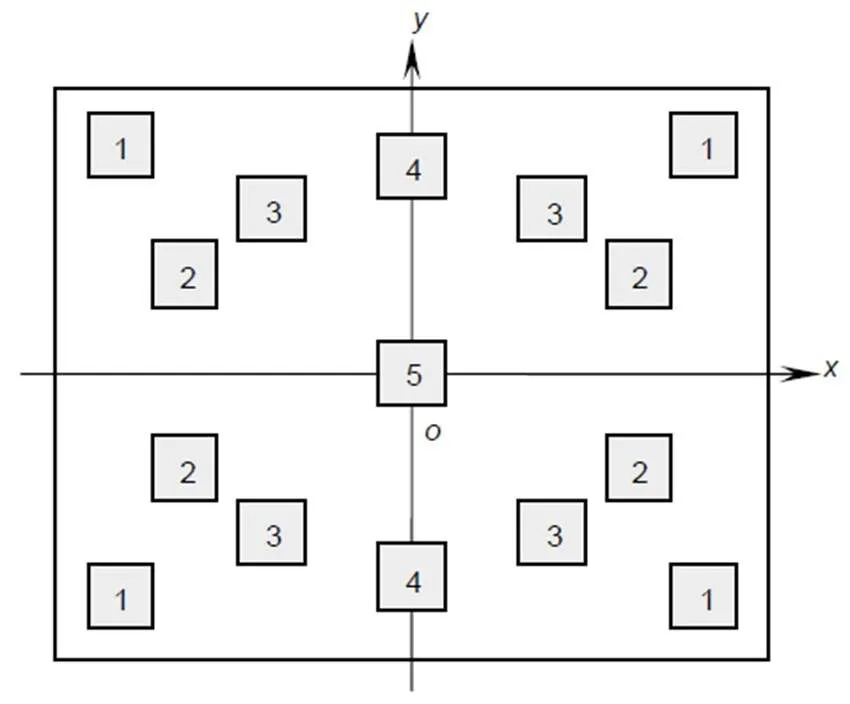
图2 LED灯布局图
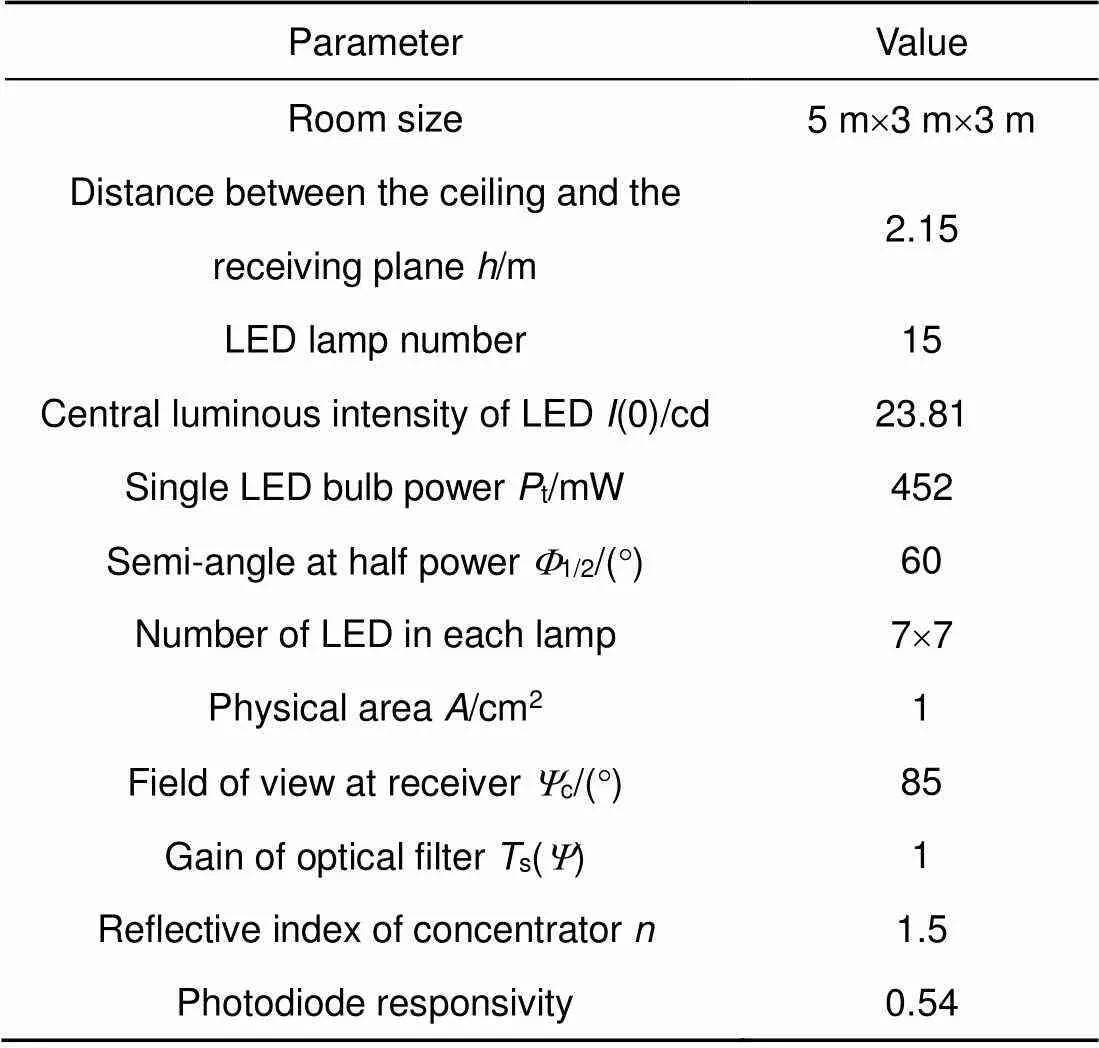
表1 系统仿真参数
位于接收平面上均匀分布的51´31个接收器接收来自所有LED的冲激响应信号,用接收平面接收功率的方差值来表征功率分布的均匀性情况,并将方差值作为该系统优化的目标函数。方差越小,功率分布越均匀。引入照度均匀度(最小照度值/照度均值)来描述照度分布情况,照度均匀度越接近1,光线分布越均匀,视觉感受效果越好。为使方差值尽可能的小,照度均匀度尽可能接近1,采用多种群遗传算法对系统模型进行优化处理,经优化后的系统可达到通信和照明的一个较优的状态。
3 多种群遗传算法设计
多种群遗传算法[11]是在传统遗传算法(genetic algorithm,GA)的基础上发展得到的。传统遗传算法采用单个种群进化的策略,交叉概率和变异概率为固定值,因此在应用时存在早熟收敛的问题,即种群个体极有可能陷入局部最优解,或是未成熟收敛问题,即算法达到最大迭代次数时,还未得到最优解。多种群遗传算法引入多个种群协同进化的策略,使用移民算子,并将交叉概率和变异概率控制在一个区间内,有效避免早熟收敛问题;同时引入精华种群,避免了未成熟收敛的问题。
算法具体操作如下。
1) 染色体编码

2) 生成初始种群
多种群遗传算法采用多个种群协同进化的方式,应用Matlab遗传算法工具箱的crtbp函数,创建10个40行140列的二维矩阵,代表了MP=10个种群,每个种群包含NIND=40个染色体个体,每个个体上有140个基因位,即生成了初始可行解集。
3) 构造适应度函数
适应度函数影响算法整体的收敛性能。种群进化过程中,染色体中适应度函数值较优的个体更接近问题的最优解,被选中的概率很大,因此该优良基因保留到下一代的可能性很大,适应度函数值是染色体能否保留到下一代的依据,从一定程度上决定了算法整体的进化过程,适应度函数的复杂度决定了算法的复杂度。本文将适应度函数设计为目标函数的倒数后再转化为求最大值问题:

4) 遗传操作
①选择操作
模拟自然界“优胜劣汰”的生存法则,采用轮盘赌选择方法,每条染色体遗传给下一代的可能性是该染色体个体适应度值与种群中所有染色体个体适应度值和之比。该方法确保适应度值大的染色体个体能有较大的几率遗传给下一代,优秀染色体个体适应度函数值依次增加,逐渐向最大值逼近。
② 交叉操作
采用单点交叉的方式,随机配对的两条染色体个体按照交叉概率相互交换部分基因,产生新的染色体个体。交叉概率决定了算法的全局搜索能力,针对传统遗传算法交叉概率取值不同而导致寻优结果不同的问题,多种群遗传算法将交叉概率限制在一个区间内,在染色体个体适应度值高时减小交叉概率,反之增大,确保算法的稳健性。
③变异操作
采用位点变异的方式,按照变异概率改变染色体个体的某些基因值,产生相似的染色体。变异概率决定算法的局部搜索能力。与交叉类似,多种群遗传算法在染色体个体适应度值高时减小变异概率,反之增大,可有效地加快算法收敛。
④移民操作
多种群遗传算法中多个种群协同进化,各种群间通过移民算子进行信息交流,移民算子用适应度值大的个体去替换适应度值小的个体,加快了算法的收敛速度并有效防止算法陷入局部最优。
⑤算法终止
多种群遗传算法将所有种群每次迭代的最优染色体个体保存到精华种群,不再参与遗传操作,当精华种群中最优个体出现次数超过算法初始设定的最优个体最少保持代数时,即为最优解,此时算法终止,解决了传统遗传算法未成熟收敛的问题。
多种群遗传算法的详细参数如表2所示,流程图如图3所示。
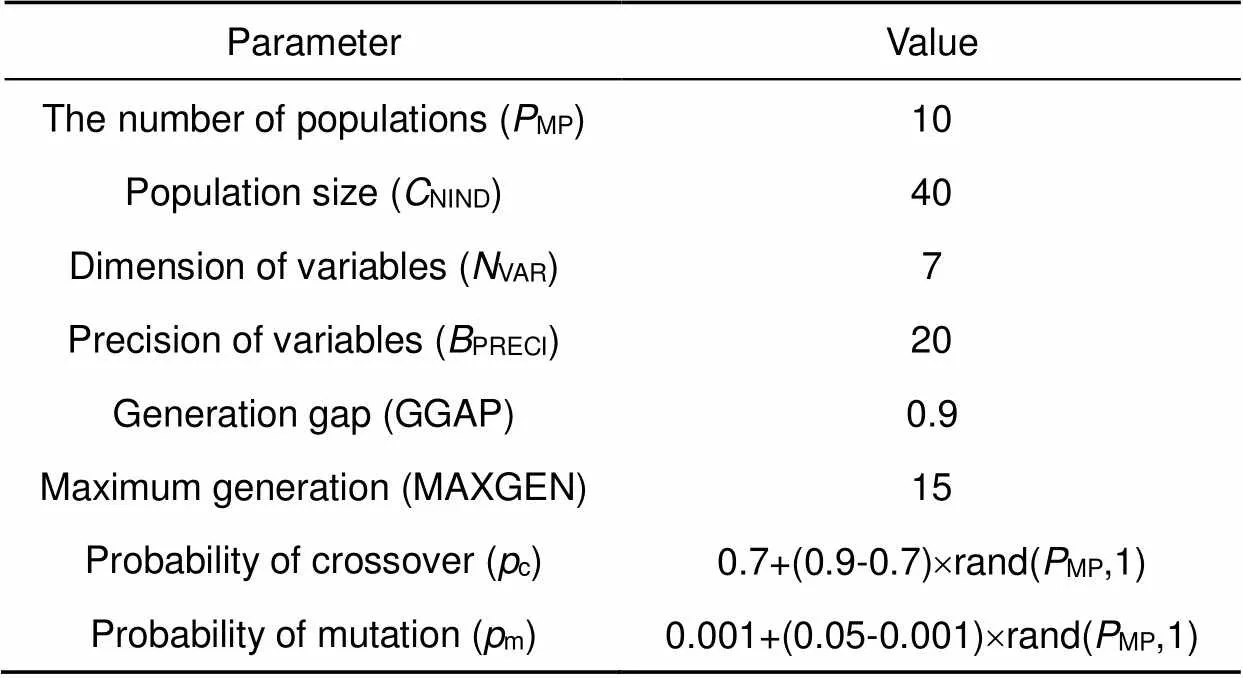
表2 算法参数表
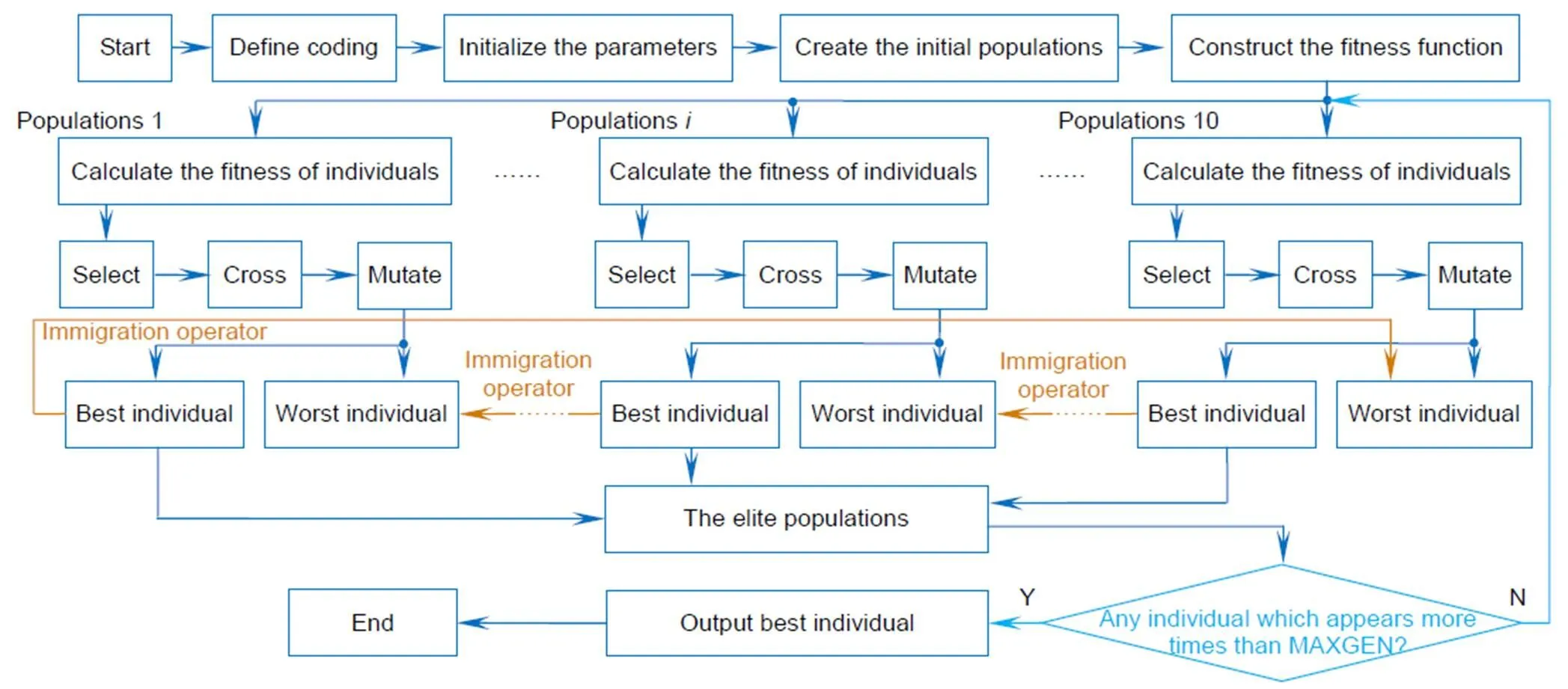
图3 算法流程图
4 仿真实验与数据分析
可见光通信系统实验仿真平台为Matlab R2016a。经MPGA算法优化得到的位置参数为1=2.5,2=2.5,3=1.57;1=1.5,2=1.03,3=1.5,4=1.5。将优化后的变量代入仿真系统模型,得到图4所示的照度和功率分布图。设定GA的交叉概率c为0.7,变异概率m为0.05,GA优化得到的位置参数为1=2.42,2=1.57,3=2.49;1=1.11,2=1.46,3=1.28,4=1.5,优化后的照度和功率分布如图5所示。陈勇等[12]曾针对5 m´5 m正方形的天花板提出5´5 LED布局,借鉴该模型,本文对5 m´3 m的长方形天花板提出5´3矩形布局,并采用MPGA优化位置参数,作为实验的对比,验证本文所提方案的可行性,矩形布局参数分布如图6所示。三种方案LED灯的布局图如图7所示。
MPGA与GA优化后的功率分布图大体相似,均四个角落处各有较高的波包,中间区域微微隆起,四边呈现幅度较大的滑坡,直观上分布较均匀,从底部的等高线图来看,MPGA优化分布在中间和四角区域等高线分布更为稠密,即功率分布图在此处更为陡峭些,GA优化功率分布则较平缓,鉴于功率分布隆起的部分可以平衡凹陷的部分,MPGA优化分布要优于GA优化,且MPGA优化后功率覆盖区间比GA优化后的结果要小,因此MPGA优化效果要优于GA;矩形布局优化后功率呈现马鞍面形状的分布,功率集中分布在房间的宽度中间区域,等高线分布稀疏,功率分布覆盖区间非常大,功率分布隆起部分远不能抵消凹陷部分,效果最不理想。三种方案照度分布与功率分布情况相似。从图7上看,MPGA和GA优化后的LED灯除中轴线外,其余分布在天花板边缘,而矩形布局下仍有LED灯分布在中间区域。具体参数如表3所示。
从表中得到,本文所提经MPGA优化后的LED布局方案功率方差达到1.5744 dBm,其余两种方案功率方差偏大,即表示MPGA优化后的LED布局下接收功率分布均匀性最好。在照度方面,三种方案的照度都达到了ISO规定,MPGA优化后布局的照度范围为889 lx~1009 lx,区间长度最小,均匀性达到91.73%,优于GA优化布局和MPGA优化矩形布局下的结果,验证了所提方法的可行性。
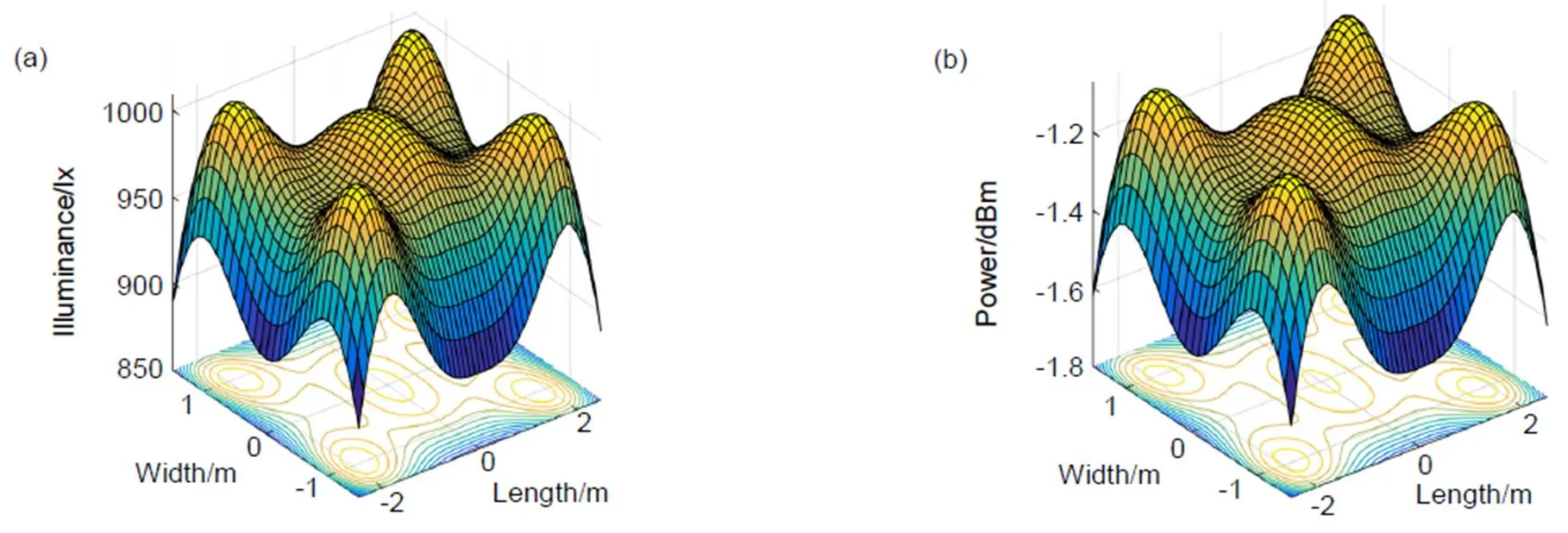
图4 MPGA优化参数分布图。(a) 照度;(b) 功率
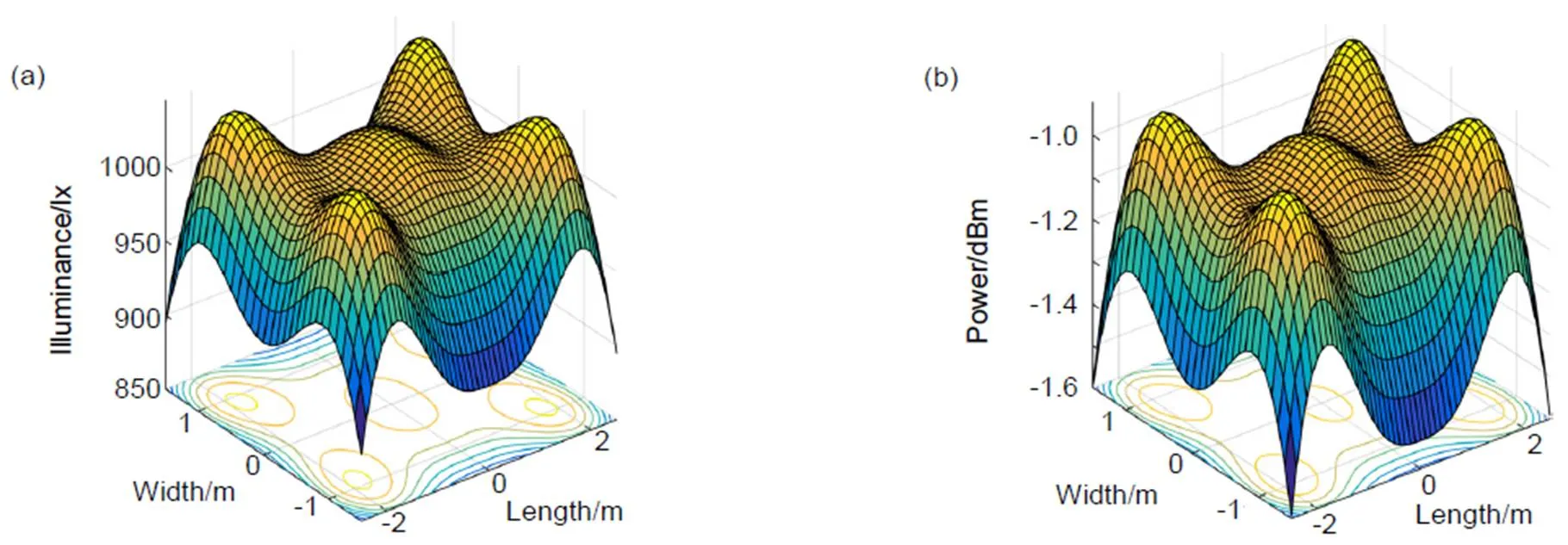
图5 GA优化参数分布图。(a) 照度;(b) 功率
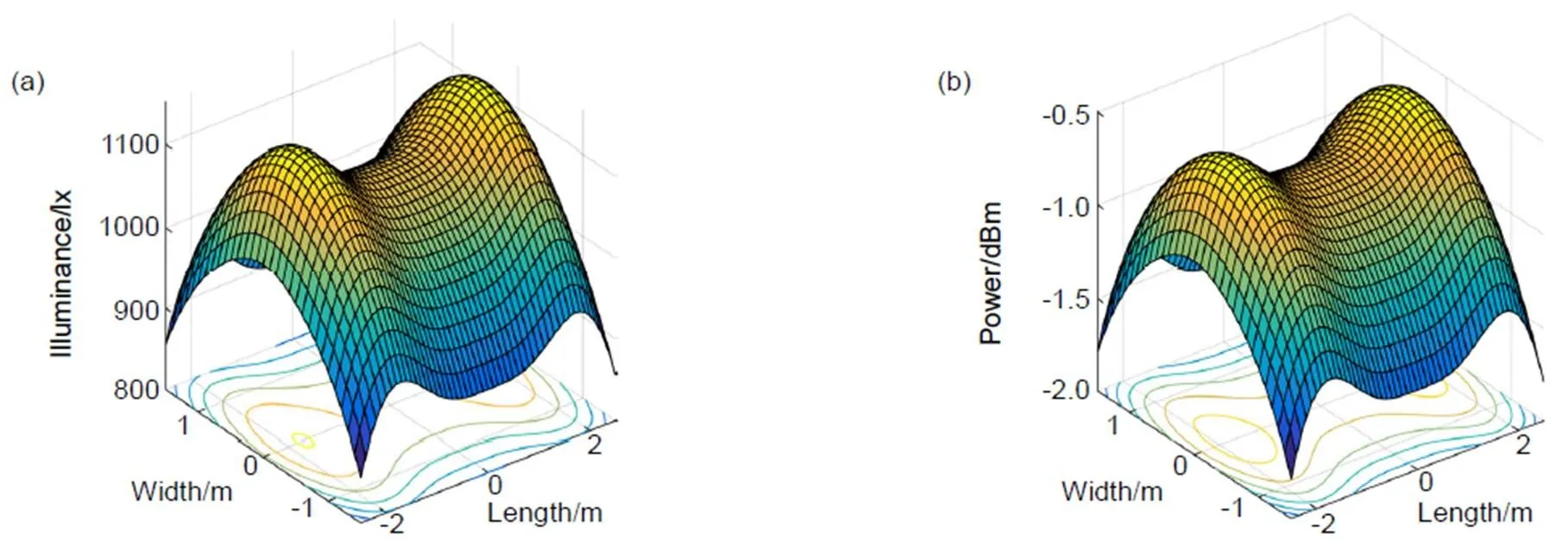
图6 MPGA优化矩形布局参数分布图。(a) 照度;(b) 功率
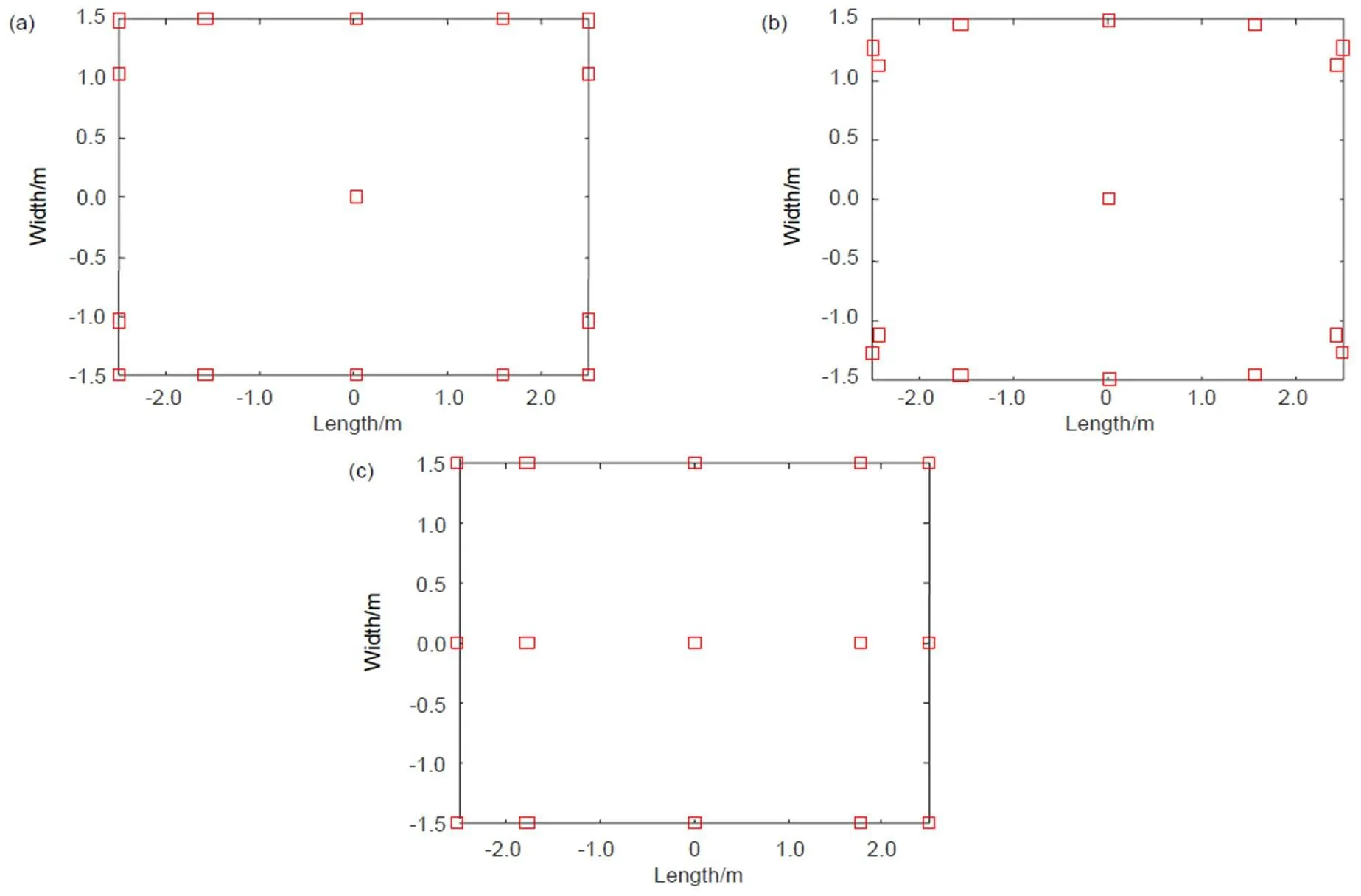
图7 LED灯布局图。(a) MPGA优化;(b) GA优化;(c) 矩形布局

表3 布局参数表
5 结 论
可见光通信系统中存在功率分配不均匀影响用户体验的问题。本文以5 m´3 m´3 m房间作为系统模型,以置于天花板上15个LED灯为例,通过Matlab R2016a模拟仿真室内接收的光照度和功率情况。为达到功率分布更均匀采用多种群遗传算法,将LED灯位置信息作为染色体个体,构造和功率方差有关的适应度函数,多种群遗传算法在传统遗传算法的基础上引入移民算子和精英保留策略,经多个种群协同进化求得最优解。代入仿真模型中,求得通信系统照度和接收功率分布情况,并引入传统遗传算法优化布局和多种群遗传算法优化的矩形布局作为对比。实验证明,经多种群遗传算法优化的布局功率分布直观上感受最均匀,方差可达到1.5744 dBm,照度范围在889 lx~1009 lx之间,照度均匀度达到91.73%,均优于其余两种方案。从而,为可见光通信系统寻求已定LED灯的最佳位置提供了一种可靠的借鉴方案。
[1] Xu Y Q, Hua J, Gong Z,. Visible light communication using dual camera on one smartphone[J]., 2018, 26(26): 34609‒34621.
[2] Chi N, Hass H, Kavehrad M,.Visible light communications: demand factors, benefits and opportunities[J]., 2015, 22(2): 5‒7.
[3] Rajagopal S, Roberts R D, Lim S K. IEEE 802.15.7 visible light communication: modulation schemes and dimming support[J].2012, 50(3): 72‒82.
[4] Komine T, Nakagawa M. Fundamental analysis for visible-light communication system using LED lights[J]., 2004, 50(1): 100‒107.
[5] Zhao L, Peng K. Optimization of light source layout in indoor visible light communication based on white light-emitting diode[J].2017, 37(7): 0706001.
赵黎, 彭恺. 基于白光发光二极管的室内可见光通信光源布局优化[J]. 光学学报, 2017, 37(7): 0706001.
[6] Wang J A, Che Y, Lü C,. LED layout for indoor visible light communication based on energy optimization[J].2017, 37(8): 0806003.
王加安, 车英, 吕超, 等. 基于能量最优的室内可见光通信LED布局[J]. 光学学报, 2017, 37(8): 0806003.
[7] Ding J P, Huang Z T, Ji Y F. Evolutionary algorithm based power coverage optimization for visible light communications[J].,2012, 16(4):439–441.
[8] Liu H L, Wang X, Chen Y,. Optimization lighting layout based on gene density improved genetic algorithm for indoor visible light communications[J].2017, 390: 76–81.
[9] Ding D Q, Ke X Z, Xu L P. An optimal lights layout scheme for visible-light communication system[C]//, 2007: 2–189–2–194.
[10] Liu H L, Liu Z Y, Xu Y,. Coverage uniformity with improved genetic simulated annealing algorithm for indoor visible light communication[J]., 2019, 439: 156–163.
[11] Jiao Y L, Zhang P, Tian G D,. Slotting optimization of automated warehouse based on multi-population GA[J].(), 2018, 48(5): 1398–1404.
焦玉玲, 张鹏, 田广东, 等. 基于多种群遗传算法的自动化立体库货位优化[J]. 吉林大学学报(工学版), 2018, 48(5): 1398–1404.
[12] Chen Y, Shen Q X, Liu H L. Optimization algorithm of receiver optical power uniformity in indoor visible light communication[J]., 2018, 45(5): 0506003.
陈勇, 沈奇翔, 刘焕淋. 室内可见光通信中接收光功率均匀性优化方法[J]. 中国激光, 2018, 45(5): 0506003.
An optimized light source layout model for visible light communication system
Liu Hong1,2*, Zhai Changxin1,2, Wen Yanyan1,2, Xi Lei1,2, Du Zongyu1,2
1School of Photo-Electronic Engineering, Changchun University of Science and Technology, Changchun, Jilin 130022, China;2National Demonstration Center for Experiment Opto-Electronic Engineering Education, Changchun University of Science and Technology, Changchun, Jilin 130022, China
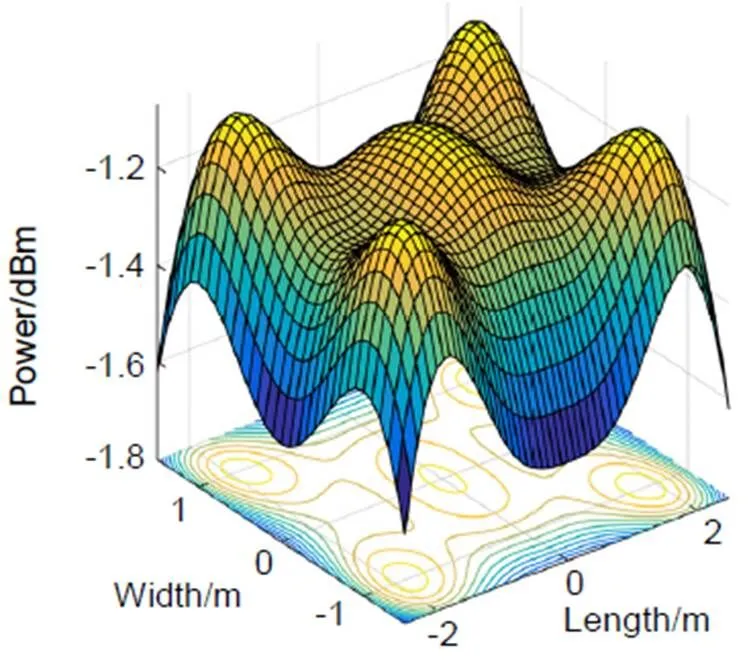
Power distributions under the proposed layout optimized by MPGA
Overview:With the rapid development of technology, traditional wireless communication can’t quite meet the needs of fast-growing data service gradually. Researchers are seeking new ways to overcome this conundrum. Since the light communication has the advantages of high SNR, high modulation rate and high security, it is promising to achieve a new height in data communication system. Visible light communication also becomes a hot field for scientists to explore. However, there are many problems to solve in order to make a perfect visible light communication system. Due to the LED lamps discretely mounted on the ceiling, distributions of illuminance and power are incredibly uneven on the receiving plane, so that user experiences can’t be exhilarating. To create a better atmosphere for communication, a layout optimized by multi-population genetic algorithm is proposed. Traditional genetic algorithm may get involved in premature convergence or running into a local optimization solution. The strategy of multi-population co-evolution is introduced into multi-population genetic algorithm to get rid of these problems. The immigration operation strengthens the bond of multi-populations, and the elitism strategy makes sure that the result is found out under our request. A room with dimensions 5 m´3 m´3 m plays the role of simulation model. Particularly, the base of the model is rectangular, which is different from most of the previous studies. 15 specific LED lamps are mounted on the ceiling and serve as sources of optical illuminance and power. The position coordinates of lamps make up chromosome individuals. A function related to the variance of the receiving power is constructed as the fitness function. After being optimized by the algorithm, parameters are plugged into the model simulated on Matlab R2016a. Furthermore, to illustrate the effectiveness of the proposed method, layout optimized by traditional genetic algorithm and rectangular layout optimized by multi-population genetic algorithm are taken as comparisons. The diagrams show that parameters of the proposed method are the evenest intuitively. Through the numerical analysis, the variance of power reaches 1.5744 dBm, the illuminance falls in a range between 889 lx and 1009 lx and the uniformity ratio of illuminance is 91.73%, all of these parameters in multi-population genetic algorithm (MPGA) are the best among the three methods mentioned above. Therefore, the feasibility of this optimization method is evidently proved by this experiment. It can provide references when people tend to find a way to properly design the LED layout, thus finally contributes to building the visible light communication system.
Citation: Liu H, Zhai C X, Wen Y Y,An optimized light source layout model for visible light communication system[J]., 2020, 47(7): 190565
An optimized light source layout model for visible light communication system
Liu Hong1,2*, Zhai Changxin1,2, Wen Yanyan1,2, Xi Lei1,2, Du Zongyu1,2
1School of Photo-Electronic Engineering, Changchun University of Science and Technology, Changchun, Jilin 130022, China;2National Demonstration Center for Experiment Opto-Electronic Engineering Education, Changchun University of Science and Technology, Changchun, Jilin 130022, China
To solve the unevenness of distributions of optical illuminance and power in visible light communication system, a light source layout based on multi-population genetic algorithm is proposed. Taking 15 LED lamps as an example, the position coordinates were optimized under the fitness function related to variance of received power through the co-evolution of multi-populations. The simulation results on Matlab R2016a showed that, after being optimized, the distribution of power was evener intuitively, the variance of power reached 1.5744 dBm, the illuminance fell in a range between 889 lx and 1009 lx and the uniformity ratio of illuminance was 91.73%, all of which were better than those of the layout optimized by traditional genetic algorithm and the rectangular layout optimized by multi-population genetic algorithm. This experiment provides a feasible solution for optimizing the visible light communication system so that users can have a more comfortable communication trip in this system.
visible light communication system; light source layout; the uniformity ratio of illuminance; the evenness of power; multi-population genetic algorithm
TN929.12
A
10.12086/oee.2020.190565
: Liu H, Zhai C X, Wen Y Y,. An optimized light source layout model for visible light communication system[J]., 2020,47(7): 190565
刘红,翟长鑫,文燕燕,等. 可见光通信系统光源优化布局模型[J]. 光电工程,2020,47(7): 190565
* E-mail: zhaixin1997@gmail.com
2019-09-21;
2020-01-16
刘红(1969-),女,硕士,教授,硕士生导师,主要从事智能测试和模式识别方向的研究。E-mail:zhaixin1997@gmail.com

